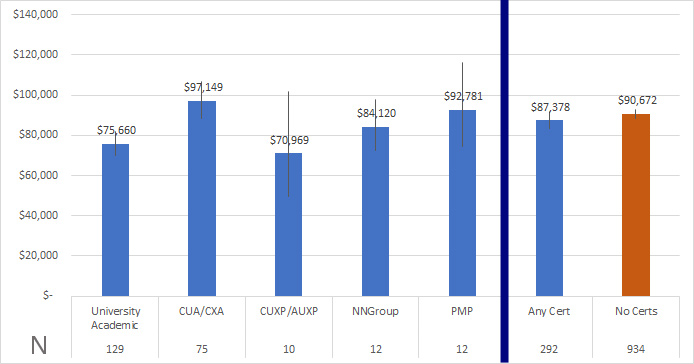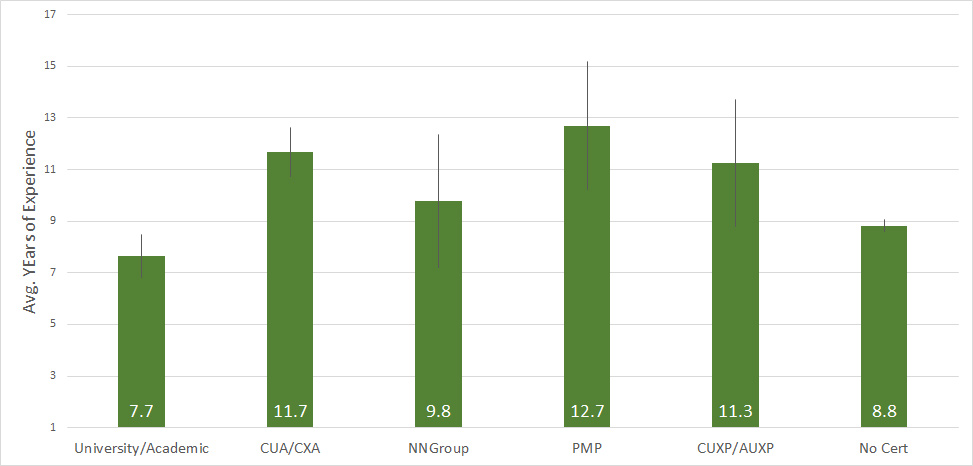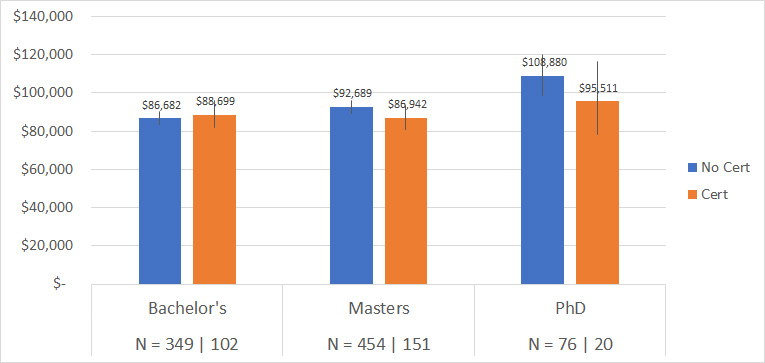 There’s been a long heated debate within the industry about the need to certify User Experience practitioners.
There’s been a long heated debate within the industry about the need to certify User Experience practitioners.
After all, many professional organizations—accountants, realtors, attorneys, and even ergonomists—have some sort of official certification.
Certifications provide some indication that a minimum threshold of competence has been demonstrated, which in theory should help prospective employers, customers, and the industry as a whole. Certification may even be helpful with the perennial confusion between UI and UX.
While this debate will continue, several organizations already offer varying degrees of certifications, including HFI and Nielsen Norman Group, and there are certified university courses (including our own UX Boot Camp).
Certification is a challenging topic, as is higher education in general, because it involves multiple prongs that are debated:
- The content and experience one needs
- The credential one receives
- The cost—usually a non-trivial amount of money
While there will inevitably be some disagreement on what content should be included in a certification program, there’s likely high agreement on several core concepts and activities. So while few can argue against the benefits of the knowledge and experience gained from a certification, many do wonder whether the credential and its corresponding cost are worth the price.
After all, a motivated person can read a few books and papers, watch free online videos, and conduct some projects to get real-world experiences and knowledge (just as in higher education). As Matt Damon’s character colorfully expressed in Good Will Hunting:
“You dropped 150 grand on an education you could have got for a dollar fifty in late charges at the public library!”
I explored a similar topic 7 years ago when examining whether a PhD was worth the price. The short answer was, on financial grounds alone, there is increased pay for practitioners with PhDs. However, the increased salary generally doesn’t overcome the years of deferred income from being out of the workforce (the knowledge and experience can of course be invaluable).
With professional certifications, there isn’t years of deferred cost from being out of the workforce, but there is the cost and some time. Most certification courses cost between $3,000 and $10,000 and cover everything from usability testing essentials to UX design and principles and usually last a few days to weeks.
To understand whether there is any evidence of financial gain from obtaining a certification, I examined the UXPA salary data from 2016 that we reported earlier this year. Among other things, participants were asked whether they have any certifications.
Results
Of the 1,355 survey responses, 324 (24%) had some type of UX certification, either from a private company (like HFI or Nielsen Norman group) or an academic affiliation. Of the 1,355 responses, 1,226 had some usable salary data and 292 of these had some type of certification (7 respondents had more than one certification).
I found no statistical difference between the mean (log-transformed) salaries of respondents with certifications and those without (p = .25). In fact, the nominal salary is actually 4% lower for those with certifications in general (right side of Figure 1 below).
Figure 1 also shows the average (log-transformed) salaries for respondents by certification type. Only certification types with at least 10 responses are shown (not shown are CPE/AEP/CEA, CHFP/AHFPC, CBA/CBAP, and “other” responses).
University and academic certificates have the greatest portion of certificates (129 of 292 or 44% of all certifications) but also had a mean salary about 17% lower than respondents without any certification (p< .01). The next largest group was from HFI’s CUA/CXA program with 75 participants (26% of the certifications), which was the only certification program that had a higher nominal average salary than participants without a certification (although the difference is not statistically significant, p = .15).

Figure 1: Average salary (log-transformed) for certification programs with at least 10 responses (left side of figure) compared to average salary for all responses with and without certifications (right side of figure).
The fact that the average salary is lower for respondents with certifications does not mean that the process of obtaining a certification actually lowers salaries any more than exercise causes obesity. It’s much more likely that those who want to break into the field, continue their education, or don’t have a degree in a UX-related field may be more likely to seek out certification. It could also be from a confounding variable.
We saw with UX salaries that two of the biggest drivers of salary were years of experience and education level. In that analysis, having a certification was not a significant driver, and in fact this data is showing why—respondents with certificates tend to have lower, not higher, average salaries. But not being a significant driver means that the variation in certification was accounted for by other variables in the analysis.
When examining years of experience, respondents with certificates tend to have less experience, about 12% less, or 1 year less than their non-cert holding counterparts. Figure 2 shows the mean years of experience per certification type.
Figure 2: Average years of experience respondents had for each certification type compared to no certifications “No Cert”.
Respondents with the CUA/CXA certification (HFI’s program) have more experience than NNGroup and especially university programs—52% more years of experience (~12 vs 8 yrs respectively; p < .01). In other words, differences in salaries across certification levels can be accounted for by years of experience. The NNGroup certification is a more recent addition compared to the CUA/CXA and PMP certifications that have a longer tenure.
We’re likely seeing higher salaries for the CUA/CXA and PMP groups because they’ve been around longer and respondents with these certifications have more years of experience. The opposite is likely true for university programs that may be more recent additions. Knowing when respondents received their certifications will help better understand the effects of certification on salary (data we currently don’t have).
This pattern was more mixed across education levels (see Figure 3). Participants with Bachelor’s degrees who had a certification tended to have a slight (but not statistically) higher salary. For Master’s and PhD respondents with certifications, their salaries were lower (but not statistically).

Figure 3: Average salary (log-transformed) for respondents with a certification and without by highest degree obtained.
Interestingly enough, this was even the case with participants with an HCI-related degree. Of the 250 respondents who had a certification and salary data, 59 had a degree in HCI but had on average a 10% lower salary (not statistically significant).
Summary
While certification programs will likely enrich the knowledge and skills of the practitioner, this analysis found little evidence certifications generate higher pay. In fact, under most circumstances, certifications are associated with lower salaries (especially for respondents with advanced degrees). However, the lower salaries are most likely from the confounding effects of years of experience. Older certification programs tend to have respondents with more years of experience; newer certification programs are associated with less experience.
This does not mean certifications aren’t financially beneficial—they very well may help open the door to a new career or provide a bump in hiring (as is the case with advanced degrees) and help practitioners gain more credibility in their jobs. Future analysis is needed to better understand the links (and covariates) of certification on salary and hiring and how different certification programs may do a better job of both preparing and rewarding their participants.
Thanks to Jim Lewis for commenting on a draft version of this article.